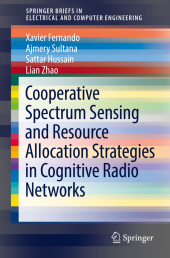 Neuerscheinungen 2018Stand: 2020-02-01 |
Schnellsuche
ISBN/Stichwort/Autor
|
Herderstraße 10
10625 Berlin
Tel.: 030 315 714 16
Fax 030 315 714 14
info@buchspektrum.de |

Xavier Fernando, Sattar Hussain, Ajmery Sultana
(Beteiligte)
Cooperative Spectrum Sensing and Resource Allocation Strategies in Cognitive Radio Networks
1st ed. 2019. 2018. x, 107 S. 38 SW-Abb. 235 mm
Verlag/Jahr: SPRINGER, BERLIN; SPRINGER INTERNATIONAL PUBLISHING 2018
ISBN: 3-319-73956-5 (3319739565)
Neue ISBN: 978-3-319-73956-4 (9783319739564)
Preis und Lieferzeit: Bitte klicken
Cognitive radio networks (CRN) will be widely deployed in the near future, and this SpringerBrief covers some important aspects of it, as well as highlighting optimization strategies in Resource Allocation and Spectrum Sensing in CRNs. The cognitive approach in radio access is introduced in the first part of this SpringerBrief, and then next the benefits of cooperative spectrum sensing are highlighted and a framework for studying it under realistic channel conditions is described. New exact closed-form expressions for average false alarm probability and average detection probability are derived in this scenario. A novel approximation to alleviate the computational complexity of the proposed models are also discussed.
Once the spectrum opportunities are identified, efficient and systematic resource allocation (RA) shall be performed. The second part of this SpringerBrief describes the taxonomy for the RA process in CRN. A comprehensive overview of the optimization strategies of the CRN RA is also provided. The device-to-device (D2D) communication scenario is discussed, then as a case study and various optimization strategies for the application of the CR technology in the D2D realm is studied. The application of advanced geometric water-filling (GWF) approach in CRN D2D environment for optimum resource allocation is presented in detail. Numerical results provide more insight quantitatively. Overall, this book is suitable for a wide audience that include students, faculty and researchers in wireless communication area and professionals in the wireless service industry.
Contents
List of Figures
List of Tables
List of Abbreviations
1 Introduction
1.1 An Overview of Cognitive Radio Networks (CRNs)
1.2 Cooperative Spectrum sensing in CRNs
1.2.1 Spectrum Sensing Challenges
1.2.2 Spectrum Sensing Methods
1.2.3 Diversity Combining Techniques
1.2.4 Spectrum Sensing over Fading Channels
1.2.5 Sensing and Relaying Channels
1.2.6 Cooperative Spectrum Sensing Models
2 Relay-Based Cooperative Spectrum Sensing
2.1 Single-Relay System Model
2.2 Multi-Relay System Model
2.3 End-to-End Performance over Rayleigh Fading Channels
2.4 End-to-End Performance over Non-Identical Nakagami- m Channels
3 Cluster-Based Cooperative Spectrum Sensing
3.1 Network Model
3.2 The Clustering Algorithms
3.3 Convergence Acceleration
3.4 Throughput Analysis
3.5 Performance Evolution
4 Taxonomy of the Resource Allocation in CRNs
4.1 Resource Allocation Approaches
4.2 Architecture
4.3 Basic Elements or Objectives
4.4 Resource Allocation Strategies
4.4.1 Heuristic
4.4.2Optimization
4.4.3 Graph Theory
4.4.4 Game Theory
4.4.5 Genetic Algorithms
4.4.6 Particle Swarm Intelligence Algorithms
4.4.7 Geometric water-filling (GWF)
5 Resource Allocations in CRNs
5.1 Resource Allocation in OFDM-based CRNs
5.2 Cognitive Radio System Model and Transmission Power Constraint
5.3 Problem Formulation
5.4 Subcarrier Allocation
5.5 Power Allocation using GWF Approach
5.6 Iterative Partitioned Weighted Geometric Water-Filling with Individual Peak Power (IGPP)
5.7 Performance Evaluation
6 Resource Allocationsin CRNs with D2D Communication
6.1 Resource Allocation for CRNs with D2D Communication
6.2 System Model
6.3 Problem Formulation
6.4 Proposed Resource Allocation Scheme
6.5 Adaptive Subcarrier Allocation (ASA)
6.6 Power Allocation (PA)
6.7 Performance Evaluation
7 Conclusion and Future Research Directions
7.1 Conclusion
7.2 Future Research Directions
7.2.1 Spectrum Sensing Issues
7.2.2 Channel Models
7.2.3 Cross-layer Design Approaches and Security Issues
7.2.4 Spectrum Mobility Issues
7.2.5 Multi-hop Scenario
7.2.6 Quality of Service (QoS) Management
References


